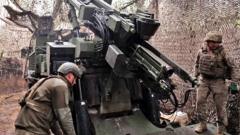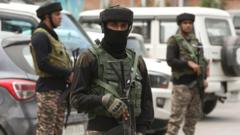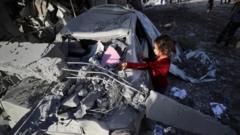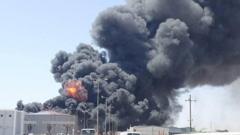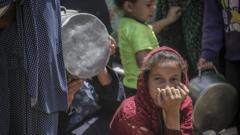As tensions rise again, families living along the Line of Control face constant uncertainty in a conflict-stricken region.
**The Perils of the India-Pakistan Border: Current Threats Amidst a Fragile Peace**
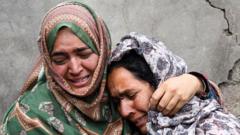
**The Perils of the India-Pakistan Border: Current Threats Amidst a Fragile Peace**
Unpacking the challenges and escalations along the Line of Control between India and Pakistan.
The volatile boundary known as the Line of Control (LoC) separating India and Pakistan has long been a flashpoint for conflict, bringing immeasurable suffering to the families that reside along its terrain. The recent flare-up following the Pahalgam attack has forced the two nuclear-armed adversaries to the edge once more, as artillery shells hammered both sides, turning homes into ruins and claiming lives. Reports indicate at least 16 deaths on the Indian side, while Pakistan claims the toll is 40, leaving the true impact of the shelling open to question.
Anam Zakaria, a Canadian-based writer from Pakistan, encapsulates the grim reality faced by families near the LoC, where they find themselves at the mercy of frequent armed escalations. "Each time firing resumes, many are thrust into bunkers, infrastructure is damaged, and lives are turned upside down," she expressed in an interview. The LoC, which extends 740km within the 3,323km India-Pakistan border, has evolved since its inception in 1949, transitioning from a ceasefire line post the first war to a militarized frontier under the 1972 Simla Agreement.
While international borders crafted through conflicts are common, the LoC stands out with its history of violence and shifting power dynamics. Sumantra Bose, a London School of Economics professor, parallels it with Israel's well-known Green Line, highlighting how fragile peace can collapse with the slightest provocation. Observers note that the recent hostilities are a stark contrast to the relative calm that had persisted for four years since a ceasefire agreement was initiated in 2021.
The rise in tensions can be traced back to India's suspension of the Indus Waters Treaty, with Pakistan responding by threatening to abandon the 1972 agreement formalizing the LoC. Such developments could reshape the already precarious balance between the two nations, as experts warn of a return to cycles of violence that lead to immense suffering for civilians on both sides.
Happymon Jacob, a foreign policy expert, emphasizes that over time, ceasefire violations have largely stemmed from local military dynamics rather than high-level political strategies. During severe conflict periods, border populations can face significant displacement, reiterating the dire human cost of military actions.
Calls for turning the LoC into a formally recognized international boundary arise intermittently, yet many analysts deem such proposals impractical. The deeply entrenched narratives surrounding Kashmir complicate any moves toward resolution, with both nations clinging fiercely to their territorial claims.
As the recent escalations renew fears, ordinary citizens are left in an endless cycle of uncertainty and anxiety. "No one wants to sleep facing the Line of Control tonight," a local hotel employee remarked, encapsulating the fragile nature of peace in this contested region. The chilling reality remains—when the window opens to a battlefield, peace is merely an illusion, precariously upheld and easily shattered.
Anam Zakaria, a Canadian-based writer from Pakistan, encapsulates the grim reality faced by families near the LoC, where they find themselves at the mercy of frequent armed escalations. "Each time firing resumes, many are thrust into bunkers, infrastructure is damaged, and lives are turned upside down," she expressed in an interview. The LoC, which extends 740km within the 3,323km India-Pakistan border, has evolved since its inception in 1949, transitioning from a ceasefire line post the first war to a militarized frontier under the 1972 Simla Agreement.
While international borders crafted through conflicts are common, the LoC stands out with its history of violence and shifting power dynamics. Sumantra Bose, a London School of Economics professor, parallels it with Israel's well-known Green Line, highlighting how fragile peace can collapse with the slightest provocation. Observers note that the recent hostilities are a stark contrast to the relative calm that had persisted for four years since a ceasefire agreement was initiated in 2021.
The rise in tensions can be traced back to India's suspension of the Indus Waters Treaty, with Pakistan responding by threatening to abandon the 1972 agreement formalizing the LoC. Such developments could reshape the already precarious balance between the two nations, as experts warn of a return to cycles of violence that lead to immense suffering for civilians on both sides.
Happymon Jacob, a foreign policy expert, emphasizes that over time, ceasefire violations have largely stemmed from local military dynamics rather than high-level political strategies. During severe conflict periods, border populations can face significant displacement, reiterating the dire human cost of military actions.
Calls for turning the LoC into a formally recognized international boundary arise intermittently, yet many analysts deem such proposals impractical. The deeply entrenched narratives surrounding Kashmir complicate any moves toward resolution, with both nations clinging fiercely to their territorial claims.
As the recent escalations renew fears, ordinary citizens are left in an endless cycle of uncertainty and anxiety. "No one wants to sleep facing the Line of Control tonight," a local hotel employee remarked, encapsulating the fragile nature of peace in this contested region. The chilling reality remains—when the window opens to a battlefield, peace is merely an illusion, precariously upheld and easily shattered.




